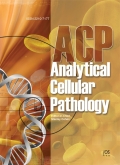Authors: Mattfeldt, Torsten | Trijic, Danilo | Gottfried, Hans‐Werner | Kestler, Hans A.
Article Type:
Research Article
Abstract:
The subclassification of incidental prostatic carcinoma into the categories T1a and T1b is of major prognostic and therapeutic relevance. In this paper an attempt was made to find out which properties mainly predispose to these two tumor categories, and whether it is possible to predict the category from a battery of clinical and histopathological variables using newer methods of multivariate data analysis. The incidental prostatic carcinomas of the decade 1990–99 diagnosed at our department were reexamined. Besides acquisition of routine clinical and pathological data, the tumours were scored by immunohistochemistry for proliferative activity and p53‐overexpression. Tumour vascularization (angiogenesis) and epithelial
…texture were investigated by quantitative stereology. Learning vector quantization (LVQ) and support vector machines (SVM) were used for the purpose of prediction of tumour category from a set of 10 input variables (age, Gleason score, preoperative PSA value, immunohistochemical scores for proliferation and p53‐overexpression, 3 stereological parameters of angiogenesis, 2 stereological parameters of epithelial texture). In a stepwise logistic regression analysis with the tumour categories T1a and T1b as dependent variables, only the Gleason score and the volume fraction of epithelial cells proved to be significant as independent predictor variables of the tumour category. Using LVQ and SVM with the information from all 10 input variables, more than 80 of the cases could be correctly predicted as T1a or T1b category with specificity, sensitivity, negative and positive predictive value from 74–92%. Using only the two significant input variables Gleason score and epithelial volume fraction, the accuracy of prediction was not worse. Thus, descriptive and quantitative texture parameters of tumour cells are of major importance for the extent of propagation in the prostate gland in incidental prostatic adenocarcinomas. Classical statistical tools and neuronal approaches led to consistent conclusions.
Show more
Keywords: Artificial neural networks, bioinformatics, classification, immunohistochemistry, incidental carcinoma, learning vector quantization, logistic regression, pathology, pattern recognition, prostatic cancer, stereology, support vector machine
Citation: Analytical Cellular Pathology,
vol. 26, no. 1-2, pp. 45-55, 2004
Price: EUR 27.50





